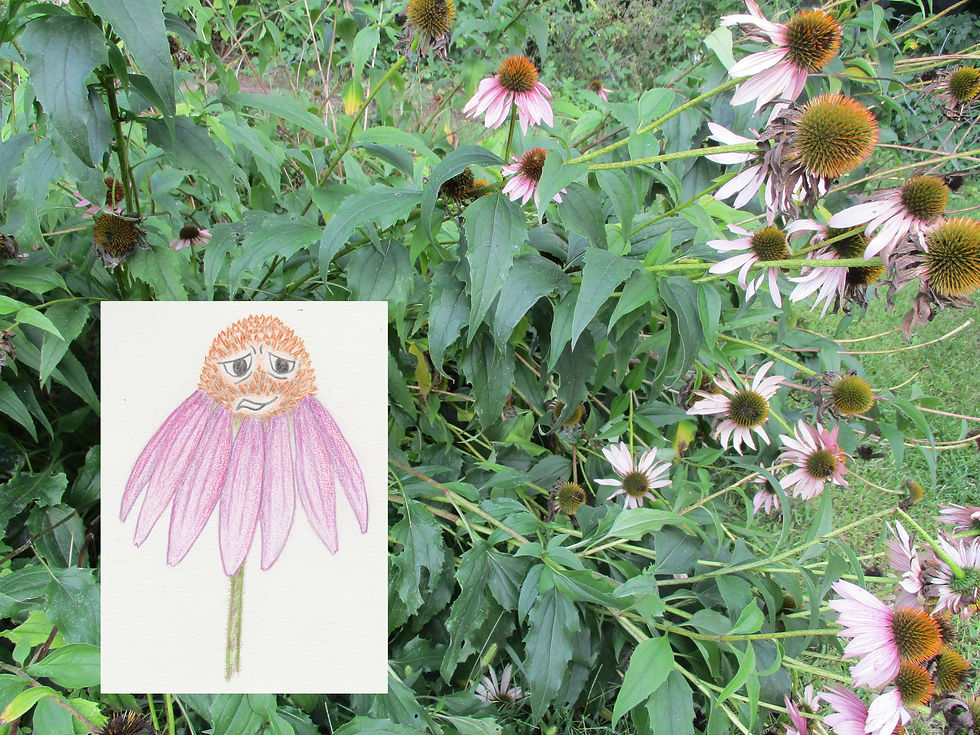Echinacea
Given Name: Echinacea purpurea
Nicknames: purple coneflower, black sampson, comb-flower, hedge sunflower, red sunflower, purple rudbeckia
Family: Asteraceae (Aster)

Do I have time for a chat? I'll check my schedule.... well, it'll be tight but I can squeeze you in. Like, I mean, right now. I'm in between a cut flower consult and a hot pollinator date so let's make this quick.
Are you ready? I'm Echinacea, an amazing plant that helps both people and the earth. You probably recognize me as an herbal remedy for preventing and treating cold and flu symptoms but did you know that I've been clinically proven as one of the safest herbal products on the market? I'm also an attractive and dependable North American native wildflower that feeds many pollinators and birds. So, whether putting me in your body or in your garden, I'm a plant that you can trust!
If you need an immune booster or a native wildflower in the future, please contact my agent. Thank you for your interest.
What?
You're calling bulls**t?
You want to know the real me?
That could be the real me... maybe you're just jealous that I'm so successful. Can't a plant have it all?
Okay...
I can't handle this silent treatment...
you're right, that spiel was so lame. Why does my publicist make me say this dribble? She always insists on “keeping up appearances” and all that jazz!
But who am I kidding? Under all my sparkle and pizazz, I'm exhausted! How can one plant handle being a native garden savior and also the poster plant for herbal medicine? There's not enough of me to go around- literally! As a commodity in Canada, the demand for Echinacea exceeds the supply!
And although I do appreciate that I was declared the plant of the year in 2014 by the United States Garden Bureau, all this attention creates so much pressure. It's too much for one plant to take! There are plenty other North American native plants that look pretty and attract pollinators. I'm sure that my native buddies, like wild bergamot, dense blazing star, New England aster, and lance-leaved coreopsis would love some of the attention that you folks lavish on me. And my herbal allies, including yarrow, calendula, elder and peppermint, would similarly appreciate a bit of press.
Share the love, people! Each of us plants has something amazing to offer and you miss out when you try to make one plant a super-plant. You also end up making that one plant (me!) very tired.
I probably would have buckled under all the pressure by now if it wasn't for my family. I share my medicinal responsibilities with 2 of the 9 species of Echinacea native to North America. The three of us have almost the same healing properties but I have to admit that my root medicine lacks some of the potency of my two siblings'. You see, E. pallida and E. angustifolia both have sturdy taproots while my fine, fibrous root system is better suited to shallow soils than making medicine. Never-the-less, because I can be grown easily and there's a lot of me, people do still dig my 3-4 year old roots, in fall after a killing frost. My roots are often dried for tea or made into a tincture (soaking them in alcohol to extract the medicine).
Although I'm run down by all this medicine making, and often cut down for medicine and for bouquets too, I know that other popular plants have it worse. Sometimes wild populations of trendy plants are severely damaged by over-harvesting.
It happened to my friend American Ginseng. That poor plant is now endangered in some places because its medicine was in such high demand.
That makes the rest of us plants kind of scared. It hasn't happened to me yet because I freely self seed and am adapted to many growing conditions but what if I'm next? It's a huge “what if” to have hanging over my head. I yearn for the simpler times before European settlers came to North America when, even though I was busy helping 14 First Nations tribes with coughs, colds, sore throats, infections, toothaches, inflammations, tonsillitis and snake bites, I was always respected and cared for.
These days, along with the fear of over-harvesting I also have to deal with the habitat loss and herbicide use that threaten my survival. My life is so much more precarious than it ever was before. The stresses and demands are making me prickly. Ha! that's ironic because my scientific name, Echinacea, comes from the Greek for hedgehog... and you can't get much more prickly than that.
Oh man, I wish I could take a vacation! I would love a beach holiday where no one knows my name!
Ooooo... stretching out my roots in sandy soil while basking in the sunshine, or even in part shade, is just the thing this weary plant needs to thrive. I think I'd be tempted to stay forever!
*Sigh*
A plant can dream, can't it?
But I can't take any time off... too many creatures depend on me. I need to just keep pushing through. Now let me see... my pollinator date is next, then tea time and my last appointment today is a naturalization project.
Oh, and I also have to remember to pencil in the the songbirds for this winter- they just tweeted to say that they'll be eating my seeds, as usual.
So much to do,
Burnt-Out Echinacea
References:
“Agriculture Overview of Echinacea Production in Manitoba” (n.d.). Government of Manitoba. https://www.gov.mb.ca/agriculture/crops/crop-management/print,echinacea.html
American Ginseng- Panax quinquefolius" (n.d.). United Plant Savers.
“Echinacea purpurea” (n.d.). Missouri Botanical Garden. https://www.missouribotanicalgarden.org/PlantFinder/PlantFinderDetails.aspx?kempercode=c580
Kindscher, K. (n.d.). “Echinacea Research”. The University of Kansas. https://kindscher.ku.edu/research/medicinal-plants/echinacea
“Specialty Croppertunties: Echinacea” (n.d.). Ontario Ministry of Agriculture, Food and Rural Affairs. http://www.omafra.gov.on.ca/CropOp/en/herbs/medicinal/echin.html
"The Truth about Echinacea: Plant commonly used for colds and flu suffers from disappearing habitat” (2014, February 3). National Science Foundation. https://www.nsf.gov/discoveries/disc_summ.jsp?cntn_id=130338&org=NSF
Another fun article... Thank you, Laura.